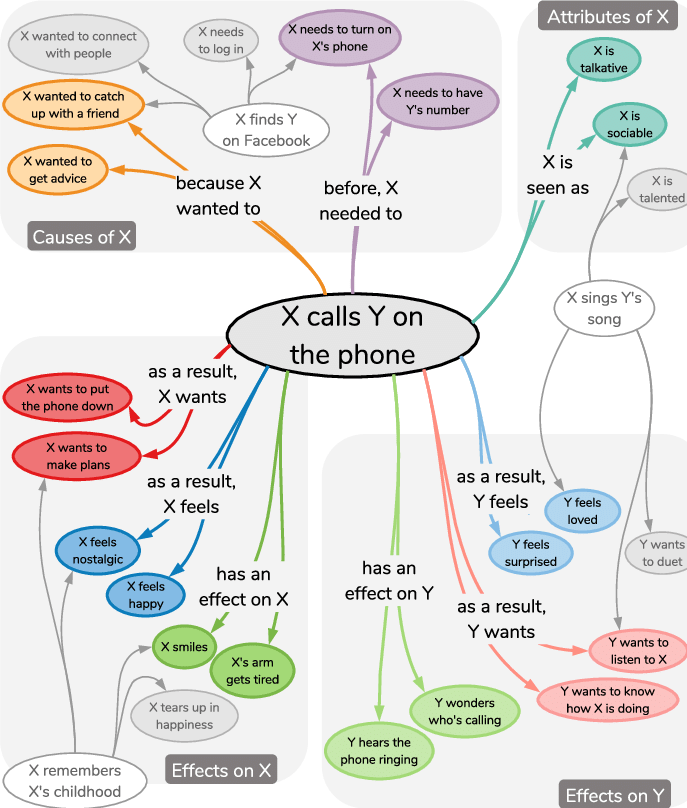Homework 4: COMET-ATOMIC Schema
Learning Objectives
- Create a schema using a commonsense knowledge base.
- Define the boundaries of your schema.
- Determine when/what knowledge bases should be used for a given task.
Instructions
ATOMIC is a crowdsourced commonsense knowledge graph that is used for state-of-the-art commonsense reasoning tasks. In this homework, you will be working with COMET-ATOMIC-2020, a BART (encoder-decoder) model finetuned on an updated version of the original ATOMIC. You will take the information provided to you by COMET-ATOMIC-2020 and structure it into a schema used to track the state of a story. (A schema is a structured representation.)
Go to the Python notebook for more information.
Part 1: Creating a Schema
You will be filling in 4 methods in the code:
- checkPrecondition: check whether or not a pre-condition passes
- getPreconditions: query COMET to get relevant pre-conditions for a given event
- getEffects: query COMET to get relevant effects for a given event
- updateSchema: update the story state to reflect these new pre-conditions & effects
Here is a diagram of how the methods relate to each other. More details can be found in the ipynb file.

Once you have implemented those parts, answer the following questions:
-
(3 pts) Explain how you made your schema. (e.g., Why did you decide to design it the way you did? What are your inputs and outputs?) (1 paragraph) You can test how your schema does on the “testing call”. Once your schema is finalized, uncomment out the 5 story blocks, and then answer the following questions for each story:
2-6. (1 pt each) What went well when processing this story? What went poorly? (2-3 sentences)
Part 2: Questions about COMET-ATOMIC
Answer each of the following with a couple of sentences:
- (2 pts) What types of stories might COMET-ATOMIC be good at tracking in general? In other words, what types of information is it good at modeling? (It might help to think about how COMET-ATOMIC compares to other knowledge bases.)
- (2 pts) What types of stories might COMET-ATOMIC be bad at tracking in general?
2a. (4 pts) Do you think any of the other knowledge bases mentioned in class could better model these? Which ones and why? If none of them could, why not?
What to Submit
- An iPython notebook called
hw4.ipynbthat runs your COMET-ATOMIC schema. Important: Save the output for the Story Tracking Questions! - A pdf that has your schema explanation and the answers to the COMET-ATOMIC questions (Parts 1 & 2 above).
Submissions should be done on Blackboard.
Grading
- Code - 4 points + 1 point extra credit
- Schema Explanation - 3 points
- Story Tracking Questions - 5 points
- COMET-ATOMIC Questions - 8 points
Related Readings
-
Jena D. Hwang, Chandra Bhagavatula, Ronan Le Bras, Jeff Da, Keisuke Sakaguchi, Antoine Bosselut, and Yejin Choi, (COMET-)ATOMIC-2020: On Symbolic and Neural Commonsense Knowledge Graphs.
-
Maarten Sap, Ronan Le Bras, Emily Allaway, Chandra Bhagavatula, Nicholas Lourie, Hannah Rashkin, Brendan Roof, Noah A. Smith, and Yejin Choi, ATOMIC: An Atlas of Machine Commonsense for If-Then Reasoning.
-
Antoine Bosselut, Hannah Rashkin, Maarten Sap, Chaitanya Malaviya, Asli Celikyilmaz, and Yejin Choi, COMET: Commonsense Transformers for Automatic Knowledge Graph Construction.
